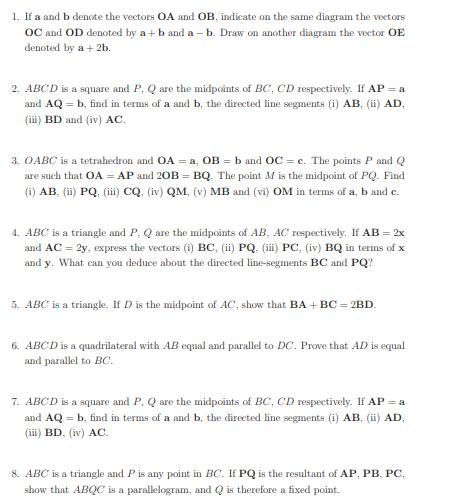Answered step by step
Verified Expert Solution
Question
1 Approved Answer
1. If a and b denote the vectors OA and OB, indicate on the same diagram the vectors OC and OD denoted by a

1. If a and b denote the vectors OA and OB, indicate on the same diagram the vectors OC and OD denoted by a + b and a- b. Draw on another diagram the vector OE denoted by a + 2b. 2. ABCD is a square and P. Q are the midpoints of BC, CD respectively. If AP = a and AQ=b, find in terms of a and b, the directed line segments (i) AB, (ii) AD, (iii) BD and (iv) AC. 3. OABC is a tetrahedron and OA a, OB = b and OC=c. The points P and Q are such that OA = AP and 20B-BQ. The point M is the midpoint of PQ. Find (i) AB. (ii) PQ. (iii) CQ, (iv) QM, (v) MB and (vi) OM in terms of a, b and c. 4. ABC is a triangle and P. Q are the midpoints of AB. AC respectively. If AB = 2x and AC = 2y, express the vectors (i) BC, (ii) PQ. (iii) PC, (iv) BQ in terms of x and y. What can you deduce about the directed line-segments BC and PQ? 5. ABC is a triangle. If D is the midpoint of AC, show that BA+BC= 2BD. 6. ABCD is a quadrilateral with AB equal and parallel to DC. Prove that AD is equal and parallel to BC. 7. ABCD is a square and P, Q are the midpoints of BC, CD respectively. If AP = a and AQ = b. find in terms of a and b, the directed line segments (i) AB. (ii) AD, (iii) BD, (iv) AC. 8. ABC is a triangle and P is any point in BC. If PQ is the resultant of AP, PB, PC, show that ABQC is a parallelogram, and Q is therefore a fixed point.
Step by Step Solution
There are 3 Steps involved in it
Step: 1

Get Instant Access to Expert-Tailored Solutions
See step-by-step solutions with expert insights and AI powered tools for academic success
Step: 2

Step: 3

Ace Your Homework with AI
Get the answers you need in no time with our AI-driven, step-by-step assistance
Get Started


